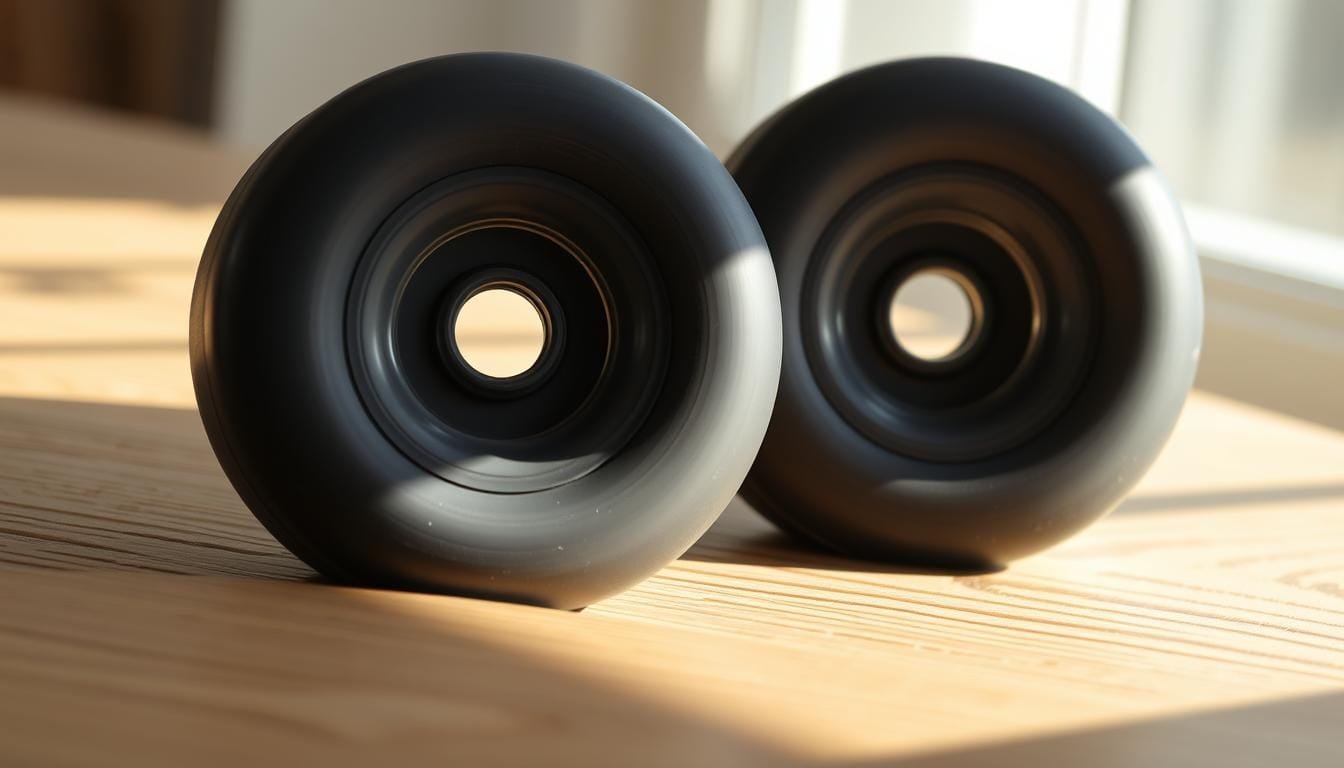Skaters sometimes forget how much wheels matter. But, the size and softness of the wheel really shape your ride. Specifically, 60mm skateboard wheels stand out for their glide over bumpy paths, making them a top pick for cruising. We’ll dive into whether these wheels perfectly combine speed with a smooth ride.
Key Takeaways
- Recommended wheel sizes for cruising range from 55mm to 65mm.
- 60mm skateboard wheels excel in balancing speed and smoothness.
- A durometer range between 78a and 85a is ideal for cruising skateboard wheels.
- Wheels measuring 60mm and above suit specialty riders on rough surfaces.
- Upgrading to larger wheels may necessitate thicker riser pads to avoid wheelbite.
Understanding Wheel Sizes and Their Impact
In the skateboarding world, knowing about wheel size is key. Wheels are measured in millimeters, from 50mm to 75mm. The size impacts your skateboarding, like speed, acceleration, and how you turn.
Street skaters prefer smaller wheels, 50-53mm, for technical tricks. They offer control and are slower, perfect for precise moves.
Wheels from 54-59mm offer a good mix of speed and control. They’re great for beginners and bigger riders, working well in different places.
Bigger wheels, 60mm and up, are for longboarders or downhill skating. They go faster and smoother, especially over rough ground or downhill. They touch the ground more, meaning less resistance and a steadier ride.
The effect of wheel size on skateboarding is clear with speed and acceleration. Smaller wheels are quick to speed up but don’t go as fast. Larger wheels, however, take longer to speed up but keep a higher speed for cruising.
The hardness of the wheels, or durometer, is also important. Soft wheels (78A–87A) are grippy and great for uneven places and cruising. Medium-hard wheels (88A–95A) provide speed and grip, good for different surfaces. Hard wheels (96A–101A+) are fast but grip less, perfect for street and park skating.
When picking effect of wheel size on skateboarding, consider both diameter and hardness. They should match your style and where you skate. Understanding how wheel size influences speed helps you make better choices.
| Wheel Size (mm) | Best For | Typical Use |
|---|---|---|
| 50-53mm | Technical Tricks | Street Skating |
| 54-59mm | Versatility | General Skating |
| 60mm and above | Speed and Stability | Cruising, Downhill |
Characteristics of 60mm Wheels
When you look into features of 60mm wheels, their balance of speed and agility stands out. They are big enough to boost your speed.
Both new and expert skaters find skateboarding with 60mm wheels beneficial. Their size makes for easier rides on different surfaces. They easily handle cracks and small stones, smoothing out your ride.
Regarding specs, 60mm wheels usually have a softness level of 75a to 90a. This softness adds grip, vital for skating on uneven grounds. Wheels rated between 78a and 87a are especially good for rough spots, helping you skate smoothly over them.
These wheels also have a big contact patch. This is the part of the wheel touching the ground, reducing resistance for a stable, smooth glide. The wheel’s shape, rounded or square-edged, also plays a role in skating performance.
Different core placements enhance the wheels’ flexibility. Backset cores make carving and sliding easier. Centerset cores balance the weight evenly for longer-lasting shape.
In essence, 60mm wheel benefits mix speed, agility, and flexibility. They are perfect for skaters who want to improve their experience across different terrains.
Benefits of Using 60mm Wheels for Cruising
Choosing the right skateboard wheels is crucial for cruising. The 60mm wheels are a popular choice. They offer many benefits that make skating more enjoyable. One key advantage is their ability to smooth rides over rough surfaces. This reduces vibrations, leading to a more comfortable ride.
60mm wheels also have a larger contact patch. This means your weight spreads out more evenly across the wheel. It reduces wear and enhances stability. This is great for skaters who want their wheels to last longer and provide a stable ride.
These wheels usually have a durometer rating between 78A and 90A. This makes them softer than street wheels. This softness is perfect for longboards and cruising. They grip the surface better, giving you more control and a smoother ride.
However, using bigger wheels like the 60mm might mean you need riser pads. This is to avoid wheel bite. But, the benefits of 60mm wheels often outweigh this small issue. They’re a top choice for those who love cruising and commuting. For more info on choosing the right skateboard wheels, check out this guide.
If you’re wondering why choose 60mm wheels for your skateboard, it’s simple. They provide a stable, comfy, and smooth ride. This makes them ideal for cruising lovers.
Limitations of 60mm Wheels
60mm wheels are great for cruising but they have some downsides. Mainly, they make it hard to maneuver. Because they are bigger, sharp turns and technical tricks are tougher than with smaller wheels. It’s important to know these limitations when building your ideal cruiser board.
Another big issue is the risk of wheel bite. This happens when the wheels touch the deck during sharp turns or when you land hard, which can cause falls. To lessen this, using risers or adjusting your trucks is often necessary. Without these tweaks, big wheels like 60mm ones can affect your skating negatively.
Larger wheels, including 60mm ones, give you speed but not quick acceleration. This slow start can be a problem for tricks. If you like quick moves and tricks, smaller wheels might be better. They’re faster to start and more responsive.
On smooth surfaces or for sliding, 60mm wheels might not be the best. Smaller, harder wheels are usually better for fast speeds and sliding. The big, soft 60mm wheels don’t work as well for these styles.
When adding 60mm wheels, you might need to change other parts to keep your board working well. Professional skaters balance wheel size and board setup carefully. Knowing the limits of 60mm wheels is key, as detailed in this helpful article.
Who Should Use 60mm Wheels?
If you’re someone who enjoys leisurely rides and values comfort over performing aggressive tricks, you are the ideal user for 60mm wheels. These wheels are great for skaters cruising on rough terrains. They offer a smoother ride than smaller and harder skateboard wheels.
Understanding who should skate 60mm wheels involves considering several types of skaters. These wheels are great for beginners. The larger size provides more stability and ease of handling, making it easier for new skaters to control and experience fewer falls.
Furthermore, if you often skate on longboards or old-school boards, 60mm wheels are perfect for you. They are great for speed and performance. They also handle rough surfaces really well. This makes them a great choice for downhill and dirt board riders.
For skaters who prioritize a comfortable and leisurely ride, the soft durometer ratings of 60mm wheels offer significant grip and shock absorption. They range from 75A to 90A. This makes them an excellent choice for commuting or casual cruising. New skaters or those who need more confidence on turns and uneven surfaces will benefit from their stability.
| Wheel Size | Best For | Durometer Range |
|---|---|---|
| 50-53mm | Trick Riding, Street Skating, Bowls | 88A-101A+ |
| 54-59mm | Beginners, Larger Riders, Vert Ramps | 88A-99A |
| 60mm and larger | Cruising, Longboarding, Downhill, Dirt Boards | 75A-90A |
The ideal user for 60mm wheels is someone who wants a smooth and comfortable ride. This can be for commuting or just casual skating. If you’re thinking about who should skate 60mm wheels, they’re great for those who prefer stability, comfort, and control over technical and aggressive skating styles.
Maintenance Tips for 60mm Wheels
Keeping 60mm wheels in good shape means paying attention to them often. You should clean your wheels regularly to get rid of dirt and debris. This stops grime from building up, which can make your wheels work poorly and wear out faster.
It’s smart to rotate your wheels every few months to prevent flat spots. Just move each wheel to the opposite corner so they wear down evenly. Always check your wheels for cracks or too much wear, like flat spots, to avoid accidents and keep control while skating.
Looking after 60mm wheels also means checking the bearings. Ensure they are tightly in place and clean them often. Dirty bearings can slow you down. For more tips on keeping skateboard wheels in top shape, check out this guide. It gives you a full overview of how the size and hardness of skateboard wheels affect your ride.
Taking good care for skateboard wheels not only makes them last longer but also gives you a safer, smoother skate. By keeping up with these maintenance steps, your 60mm wheels will keep performing well.
Conclusion: Are 60mm Wheels Right for You?
To decide if 60mm wheels fit your skating style, consider your usual riding places and how you skate. These wheels mix speed with smooth control, great for those who cruise but sometimes want a thrill. Think about whether 60mm wheels match what you like and the surfaces you often skate on.
For a smooth ride over rough spots, 60mm wheels are top-notch. They find the sweet spot between smaller wheels’ stability and bigger ones’ speed. When picking wheels for cruising, also ponder on the hardness, contact area, and size. Softer wheels (78A-87A) ensure better grip and comfort on uneven grounds.
What you like in terms of handling and board feel should lead your decision. Street skaters might choose smaller, harder wheels for tricks. But if you want a smooth sail on different surfaces, 60mm wheels are a smart pick. Looking into wheels like Spitfire Formula Four or Ricta Clouds could improve your ride. It’s key to pick wisely for the best skating experience based on your style and needs.

I’m John Peterson, a passionate skater, blogger, and lifelong enthusiast. I’ve been skating for over 9 years and have gone on to write a blog dedicated to the sport of skating and its culture. Through my blog, I strive to share my knowledge and experience of the sport with all who are interested. From beginner tips, tricks, and equipment reviews to interviews and event coverage, I cover it all. So read my blog as I explore the wonderful world of skating!

